|








|
Going Hollywood
For someone who prides himself on his love of film, I haven’t been to Los Angeles that often. I visited for a couple of days in 1997 and again in 2008. Even then, I didn’t spend that much time in the film-related areas of the city. I’ve said and I wrote that to truly love anything you need to know its history, but how much did I follow my own words? So when my wife Sarit and I were trying finish up an ill-advised timeshare, and we had the opportunity to spend a week in LA, the time felt right for many reasons.
One of those reasons was the opening of the Academy Museum of Motion Pictures. Strangely enough for what’s considered such a seminal art form, America had never boasted a top shelf museum entirely devoted to film. That’s no slight to the Museum of the Moving Image in Queens, which covers many forms of media. Other museums have covered certain types of film, such as sci-fi or Westerns. The L.A. Times opined that “The Hollywood Museum did what it could but showcasing the glamour of Hollywood is not the same thing as exploring the history, challenges, impact and failures of cinema.”
While the founders of the Academy of Motion Picture Arts and Sciences envisioned a film museum in the 1930s, the project was not formally launched until 2012, with plans to open by 2017. Turnover among the architects and leadership, fundraising problems, and then COVID pushed the opening to fall of 2021. Now that it was finally ready, it was time for me to go.
Prologue
Before the museum, Sarit and I visited Grauman’s Chinese Theater in downtown Hollywood. Technically it’s called the TCL Chinese Theater, after the company that bought the naming rights a few years ago, but to me it will always be Grauman’s. I knew about the handprints, and that was one of the few Hollywood landmarks I had visited before. Still, it’s hard not to get goosebumps knowing that classic to modern Hollywood stars had become part of film history in that very spot. There’s no particular order, so I found myself going from Harrison Ford to George Burns to Spielberg and Lucas (who shared a block), to Samuel L. Jackson to Marilyn Monroe to Paul Newman to Humphrey Bogart. According to legend, and our theater tour guide, silent film star Norma Talmadge inadvertently started the tradition when she accidentally stepped in wet cement outside the theater.
While tourists flocked to Grauman’s, that couldn’t be said for our next stop, the Larry Edmunds Bookshop. The casual fan will likely not go to Larry Edmunds, but the dedicated cinephile will. I had heard about this place at some film webinars over the past couple of years. We were asked that, if the book under discussion was sold at Larry Edmunds, to buy it there. Once I saw the place I understood why. Usually, I need to search for a film section in a bookstore, often finding it in the back somewhere. If I’m lucky it would include a full shelf. City Lights in San Francisco had four shelves with film books, which was the most I’d seen. The Larry Edmunds Bookshop sells film books and other movie memorabilia. The whole shop reflects that mission. Larry Edmunds bought the store in 1939, and after he died his partner Milton Luboviski gradually turned its focus to movies. Once there were several such bookstores in Hollywood, but now it’s just this one. It hosted book signings by Anjelica Huston, Terry Gilliam, William Friedkin, Ernest Borgnine, and, more recently, Danny Trejo.
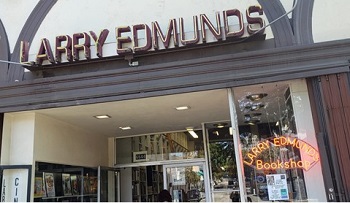
Old school in the best possible way
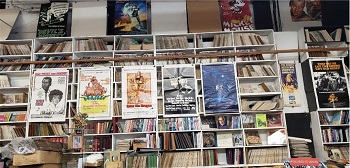
More than I could handle
I simply was not prepared for what I saw; it was almost too much, like someone used to microwave dinners being treated to a Brazilian steakhouse. Instead of merely shelves, full walls filled with more than I could read in a lifetime. After I came down off my sugar high, I browsed knowing that luggage (and wife) restrictions meant that I couldn’t buy nearly as many books as I would have liked. I could have browsed for hours, but I just didn’t have the time. The staff patiently helped me with my choices. I ended up with Trejo’s autobiography Trejo, Fasten Your Seat Belts: The Passionate Life of Bette Davis, Hollywood Independents: The Postwar Takeover, The Wild Bunch: Sam Peckinpah, a Revolution in Hollywood and the Making of a Legendary Film, and Seeing is Believing: How Hollywood Taught Us to Stop Worrying and Love the Fifties.
Museum, Part I
Now that I was properly warmed up, Sarit and I made our first appearance at the Academy Museum. We weren’t there to see the exhibits yet, but instead came for its screening of Blade Runner: The Final Cut. Thirty years ago, another re-release of Blade Runner served as my introduction to D.C.’s Uptown Theater (still hoping that comes back one day). The Museum’s David Geffen Theater wasn’t quite the Uptown, but it had its own majesty. The 1000 seat venue had me seeing red – red seats, red ceilings, red floors, and red walls. The color’s dominance felt like a performance in and of itself.
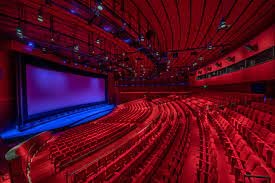
Courtesy of the Academy of Motion Picture Arts and Sciences
The Museum advertised a pre-screening Q&A with the film's art director David L. Snyder, set decorator Linda DeScenna, and chief model maker Mark Stetson. As the discussion began a woman from the audience made her way to the stage. There was a hush in the crowd as we wondered who this stranger might be. Finally, she proclaimed to the perplexed moderator “I’m Zhora!” The mysterious woman was Joanna Cassidy, who played the replicant Zhora in Blade Runner. To be honest, I don’t remember much of the Q&A, but was delighted by the idea that one of the movie’s stars (yes, she was only in a couple of scenes, but she makes them count) could just appear. Only in Hollywood.
Intermission
With the funny way our schedule played out, we did not go back to the Academy Museum right away. We went to Star Wars: Galaxy’s Edge. Technically we went to many different places in Disneyland, and I did enjoy most of them, but I was only really there for one thing. After 45 years of Star Wars fandom, standing in front of a full-size Millennium Falcon – How can I even describe what that felt like? Maybe that the 10-year-old boy somewhere inside this middle aged man was jumping for joy. Say what you want about Disney, and I have criticized the company plenty, but it gave me this experience, if by gave you mean sold it to me for $124. Still, I can’t help but be grateful. Sarit and I also got to simulate flying the Falcon. She was Han and I was Chewie. Unfortunately, we had no skills or training, and I wasn’t sure what all of the controls did. Didn’t matter, we got to see the light speed effect from the cockpit. To cap off the experience, we treated ourselves to blue milk at the Mos Eisley Cantina, the “hive of scum and villainy” or fellow tourists to be more precise. The blue milk tasted creamy with a citrus flavor and some fizz, not that the taste mattered very much. I rode in Han and Chewie’s spaceship (sort of) and drank Luke’s beverage (sort of). Not quite the force being with me, but not too bad either.
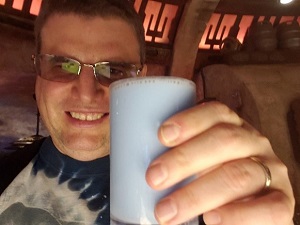
Got (blue) milk?
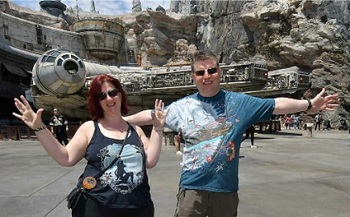
Ready for the Kessel Run
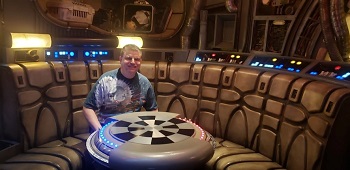
Holographic chess anyone?
Museum, Part II
Finally, we made it to the museum itself. Sleek and modern, it looked more like an art gallery than what I think of a museum. Our first stop was “The Oscar Experience.” For a few dollars more than the standard admission price, we each got to pretend we’d won an Oscar. Once I entered “the stage” a large graphic declared that “The Oscar Goes to... Adam Spector!” The music swelled, and I got to pick up a reasonable facsimile of an Oscar (as far as I could tell), and lift it triumphantly in the air. Unfortunately, the Experience did not allow for an acceptance speech, denying the public (the staff member there and Sarit) the chance to hear my brilliant reflections on how art unites all of us, not to mention my heartfelt thanks to my agent, publicist, and cat-sitter.
The exhibits themselves ranged from the old school items under glass, to multi-screen video presentations. The curators had more time than they planned to assemble the museum’s collection, and they put it to good use. They featured an early projector, an early film camera, the Citizen Kane (81-year-old spoiler alert!) Rosebud sled, the Jaws shark, C3-PO, R2-D2, E.T., a model spaceship from 2001, the head of the Alien, the videophone from Blade Runner, the storyboards for the Psycho shower scene, and much more. The costumes included Bruce Lee’s in Enter the Dragon, the Dude (Jeff Bridges) from The Big Lebowski, Phillip Marlowe (Humphrey Bogart) from The Big Sleep, Mookie (Spike Lee) from Do the Right Thing, and of course Dorothy (Judy Garland) plus a munchkin from The Wizard of Oz.
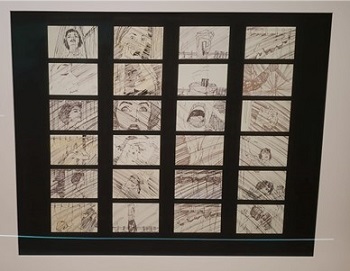
Even the storyboards are scary
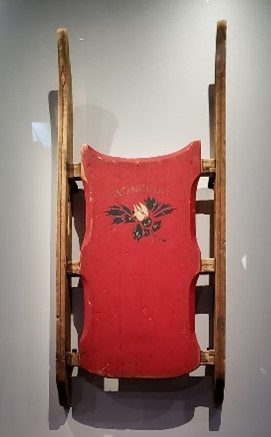
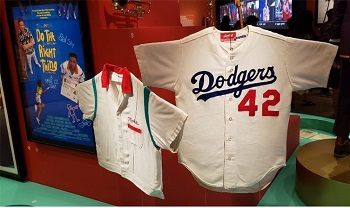
For the multi-screen presentations, I had to position myself in the right place to take in as much as possible. One had clips covering more than 100 years of movies in 15-20 minutes. Another showed clips of sci-fi films from Georges Méliès’s A Trip to the Moon to Christopher Nolan’s Interstellar. My head spun back-and-forth from one screen to another, and I think that was the point; not to focus on what was going on in any particular scene, but to immerse the viewer in the visual and sound sensations of film itself.
The museum has faced criticism for not featuring the largely Jewish men who created the classic movie studios (which it promises to add in 2023). In fact, the museum for now does not cover many integral parts of film history. Not much on Hollywood’s conversion from silents to sound pictures, the Production Code, the studio system, propaganda during World War II, the blacklist, the decline of the studio system in the late 60s, the 70s New Hollywood, the 80s corporatization, the 90s rise of indie films, or the recent dominance of superheroes and other franchise films. I would have loved to see exhibits on all of those, but I quickly decided to enjoy what was there and not bemoan what wasn’t.
The curators seemed little interested in the history of film as a whole, but rather the history of the disciplines that make up film. For example, their visual effects section included King Kong effect pioneer Willis O’Brien, the King of stop-motion Ray Harryhausen, and the James Cameron team’s work. The museum also gave its due to animation with models and pictures from early Bugs Bunny to Pixar. Innovative audiovisual exhibits on sound design and Martin Scorsese’s common camera/editing moves were among my favorites. Credit also the focus on screenwriting, with pages from the Double Indemnity screenplay, Dee Rees’s handwritten story notes from Pariah, and the typewriter Joseph Stefano used for Psycho.
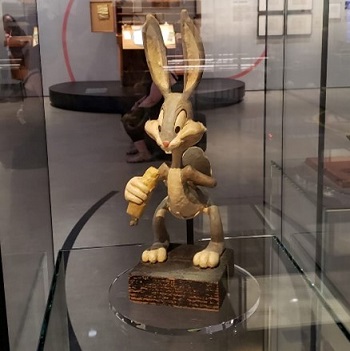
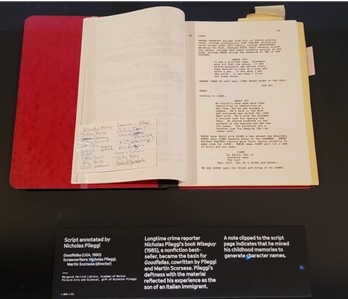
Couldn’t help but think of Ray Liotta
Not surprisingly, one area where the museum does tell a more complete story is the Academy Awards themselves going from the first ceremony (complete with an invitation) to the Will Smith slap-fest this year. This exhibit did not shy away from the Oscar mistakes, featuring the correct Moonlight Best Picture card that never got to the presenters. Perhaps the most human element was a letter Ingrid Bergman wrote to Cary Grant thanking him for accepting an Oscar on her behalf. It gave a small glimpse into their friendship, which touched me more than I thought it would. Next door was what Wanda Sykes called “Meryl Streep’s living room,” with 19 Oscars shown (and an empty display for Hattie McDaniel’s lost Oscar). Seeing so many together illustrates the pull these awards still hold, even with all the problems in Oscar history.
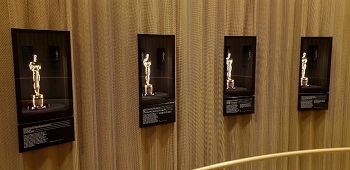
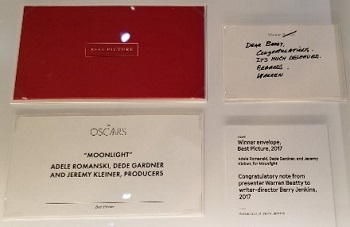
And the actual Best Picture Oscar goes to
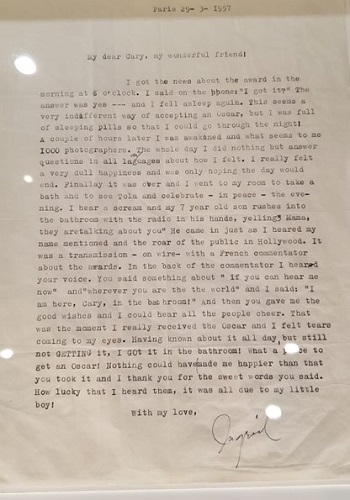
To Cary, with love
At various points in the museum, I could feel the conflict between contrasting elements. Most notably, the museum highlighted diversity while celebrating an industry that largely didn’t until recently (to a degree). It threaded that needle in one way by spotlighting Oscar Micheaux, Pedro Almodóvar and Spike Lee, and films such as Patricia Cardoso’s Real Women Have Curves. Exhibits also directly address and show examples of blackface, yellowface, redface, and other ways Hollywood demeaned minorities. To some these exhibits may smack of revisionism, political correctness or “wokeness.” The museum’s very open acknowledgment of the Indian tribe that once occupied its land might strike some people the same way.
I can understand that reaction, but I don’t agree with it. For much of Hollywood history, non-white non-straight people would either see a prejudicial, subservient view of people who looked like then, or no depiction at all, as if they didn’t exist. To acknowledge this aspect of cinema may be uncomfortable, but what’s the alternative? A quick look at the news shows people across the U.S. trying to whitewash anything they believe is not sufficiently pro-American. To me loving America or loving movies must mean looking at both honestly. More recently the Academy announced that it was apologizing to Sacheen Littlefeather, the Native American who refused Marlon Brando’s Oscar on his behalf. Many in the Oscar audience subjected her to boos and catcalls when she decried the way Indians were treated in film. Littlefeather will give a talk at the museum this month, and I wish I could be there.
Of course, I couldn’t leave the museum without one more chance to indulge my Star Wars geekdom. Don Bies, who worked for Industrial Light and Magic/Lucasfilm for 18 years, gave a talk about all that went into creating and operating R2-D2. He talked about some of the low-tech parts, including a garbage can, that went into various models of the lovable droid. Bies appeared to enjoy revisiting his work and to be moved by how much it meant to so many. In the crowd I met the former President of the Star Wars Fan Club, which counted me among its members.
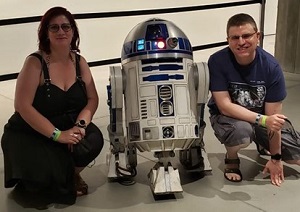
Catching up with an old friend
Epilogue
Sarit on her own booked us on the Warner Brothers tour a couple of days later. The actual touring part of it was disappointing, focusing much more on TV than film (although admittedly seeing the “Friends” fountain was cool). Much more satisfying was the studio’s own museum, which was included with the price of the tour. In a way that museum was more history based, giving a view of how the studio was created and how it evolved. It featured costumes worn by Bogart and Bergman in Casablanca, along with ones worn by James Cagney and Edward G. Robinson in their gangster movies, but also an Elvis costume from this year’s biopic. In between was not one, not two, but three different Batmobiles. I was disappointed that much of the superhero exhibits focused on the Zack Snyder versions, but all was redeemed with a Christopher Reeve Superman costume. This museum also lifted the curtain on filmmaker’s tools, letting me loop in dialogue as Morhpeus in The Matrix (Laurence Fishburne has nothing to worry about).
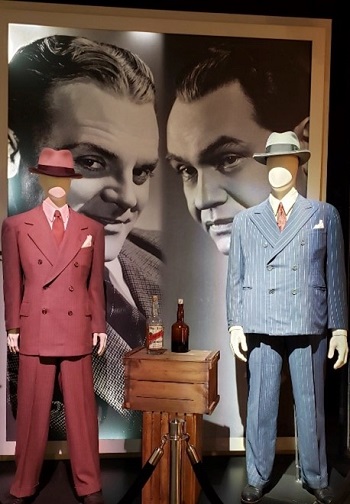
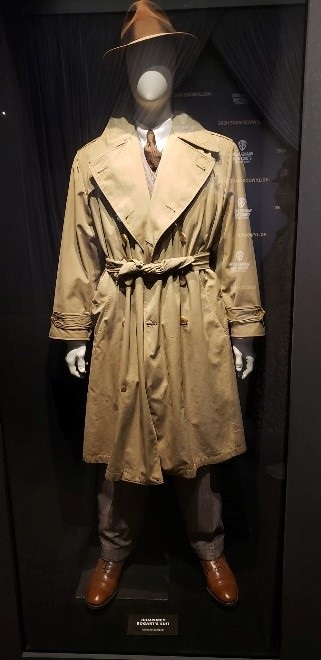
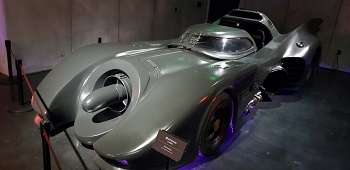
From the Tim Burton Batman
For the second leg of the trip Sarit and I headed south to San Diego, where our attention shifted from film to relaxation, but not completely. We visited the Hotel Coronado on the island of the same name, a mile from the city. The hotel hosted many of the rich and famous over the years. Most notably, it doubled for Miami in Some Like it Hot. The hotel’s gift shop played the film on a loop, and featured many Marilyn Monroe souvenirs. It served as a fitting exclamation point for a phenomenal trip that further deepened my love for movies. That’s all I could ask for.
Adam Spector
September 1, 2022
Contact us:  Membership Membership
For members only:  E-Mailing List
E-Mailing List
 Ushers Ushers
 Website Website
 All
Else All
Else
|


















